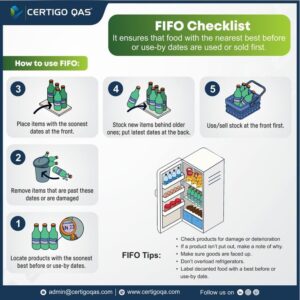In industries that handle large quantities of food—such as catering, retail, and manufacturing—efficient stock management is vital for maintaining food safety and operational efficiency. One of the most effective methods for achieving this is the FIFO (First In, First Out) storage system. Although the term may sound complex, FIFO is a straightforward principle that prioritizes using the oldest items first. By rotating food products based on their expiry dates, this system significantly reduces the risk of foodborne illnesses, minimizes waste, and boosts profitability. While restaurants commonly adopt the FIFO method, it can also be effectively implemented in home kitchens. This article explores the FIFO system, its procedures, and its impact on food safety and efficiency.
Understanding the FIFO Procedure

The FIFO method ensures that older items in inventory are used or sold before newer ones. This simple yet effective system minimizes food waste and prevents products from expiring before they are utilized. Here’s a breakdown of the FIFO process:
- Locate products with the nearest expiration or use-by dates:
- Identify items nearing their expiry dates and prioritize their usage.
- Remove expired or damaged items
- Discard any items that are past their expiration date or damaged to maintain safety standards.
- Place items with the closest dates at the front
- Move products with the nearest expiration dates to the front of shelves or storage areas for easy access.
- Stock newer items behind the older stock
- When restocking, always place newer products behind older ones to ensure the older stock is used first.
- Use or sell the front stock first
- Always utilize or sell items at the front of the shelf first to minimize the chances of spoilage.
An essential part of the FIFO process involves labelling food items that lack printed expiration dates, such as those transferred to other containers. Proper labelling ensures staff can quickly identify which items need to be used first.
Advantages of the FIFO System
The FIFO system offers several significant benefits:
- Enhanced Food Safety: FIFO ensures that older items are used before they expire, significantly reducing the risk of foodborne illnesses. This is especially critical for time-temperature control for safety (TCS) foods, such as dairy products and cold pasta, which can pose health risks if consumed past their expiration.
- Reduced Food Waste: By using items closest to their expiration dates first, businesses can minimize spoilage and waste, ultimately saving money. Preventing products from expiring before use is crucial in the food industry, where spoilage leads to lost revenue.
- Improved Stock Regulation: FIFO helps maintain proper stock rotation, preventing overstocking and ensuring older products are prioritized. This regulation optimizes storage space and enhances operational efficiency.
- Better Budgeting and Forecasting: FIFO provides insights into inventory usage, helping businesses track trends and predict future needs. Understanding usage patterns allows for more accurate budgeting and ordering, ensuring businesses can meet demand without over-ordering.
- Compliance with Food Safety Standards: By ensuring that expired items are never served, FIFO helps businesses meet essential food hygiene and safety regulations. This compliance is critical for maintaining health standards and avoiding fines.
- Simplified Stock Management: FIFO streamlines stock management processes. Most inventory management software supports FIFO by default, simplifying tracking and enhancing overall inventory control.
Challenges of the FIFO System
While FIFO offers numerous advantages, some challenges must be addressed:
- Initial Setup Complexity: Setting up a FIFO system requires organization, clear labelling, and proper staff training. Implementing the system may seem overwhelming initially, but it quickly becomes routine.
- Tracking Difficulties: Without consistent monitoring, businesses can lose track of which items should be used first. Clear labelling and regular audits can help maintain compliance with FIFO practices.
- Risk of Spoilage: In high-demand environments, there’s a risk that newer items may spoil if older items aren’t used promptly. Businesses must remain vigilant and regularly monitor stock to prevent spoilage.
Implementing FIFO in Your Business
To maximize the benefits of the FIFO system, businesses should follow these key steps:
- Label and Organize: Group similar food items together on shelves and ensure all items are clearly labelled with expiration dates for quick access.
- Track Inventory: Maintain detailed records of what’s in stock, what has been used, and what needs replenishing. Accurate records ensure FIFO functions correctly and prevent overstocking.
- Train Staff: Train both front-of-house and back-of-house staff on implementing the FIFO system, ensuring everyone involved in food handling knows how to restock and serve items efficiently.
- Handle Expired Items: Establish a plan for managing expired goods, such as donating them to local food banks or soup kitchens to reduce waste.
Key Takeaways
The FIFO system is a powerful tool for ensuring food safety, reducing waste, and improving stock management. Although challenges exist in setting up and maintaining the system, businesses can overcome these issues with proper staff training, effective labelling, and regular monitoring. By adopting FIFO, food-handling businesses can protect customers from foodborne illnesses, minimize waste, and enhance overall efficiency and profitability.
 Food Manifest
Food Manifest 


















